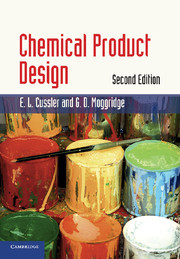9 - Microstructures
Published online by Cambridge University Press: 05 June 2012
Summary
In this chapter we turn to chemical products whose value is strongly connected to their microstructure. By “microstructure,” we mean chemical organization on the scale of micrometers. Some microstructured products are listed in Table 9.0–1. To understand how large such structures are, we remember that hair and beards grow about one millimeter in three days, or 300 μm per day. Thus, beard growth in eight hours – a “five o'clock shadow” – is about 100 μm. We can just feel this size. On the other hand, blood cells are discs 8 μm across and 3 μm thick, and we cannot feel individual blood cells. In many cases, the microstructures which we make will be between these sizes. Because they will be smaller than 100 μm, they will feel like continua, but because they are often the size of blood cells, they are not in reality homogeneous.
Another way to judge these products is their size on a logarithmic scale, shown earlier in Figure 1.5–1. On such a scale, the relative size of microstructures lies midway between the sizes of us and of individual molecules. Our little fingers are about 1 cm, or 10,000 μm, across. A microstructure of 1 μm, or 10,000 Å, is much larger than a molecule 3 Å in diameter. Microstructures are around the wavelength of visible light.
Products with microstructure supply added value because of the physical and chemical properties of the microstructure.
Information
- Type
- Chapter
- Information
- Chemical Product Design , pp. 363 - 416Publisher: Cambridge University PressPrint publication year: 2011
Accessibility standard: Unknown
Why this information is here
This section outlines the accessibility features of this content - including support for screen readers, full keyboard navigation and high-contrast display options. This may not be relevant for you.Accessibility Information
- 1
- Cited by
